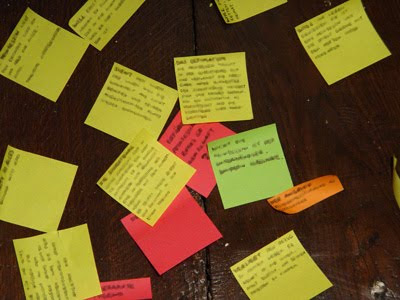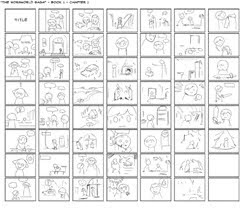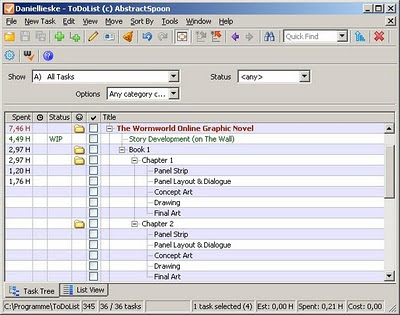
I have completed the first of the three parts of the story and currently it's divided into 7 chapters.

That's less then I thought. Well, we will see how accurate this estimation is. The first chapter will teach me a lot of valuable lessons in this respect. I have started to draw all the panels of chapter 1 into a single photoshop file.

The idea is to draw every panel the same size and then paste them into the layout document and to stretch them there into their individual sizes. Still a lot to experiment here. I have already worked a bit on the layout file and my experience up to this point is, that this method works quite well with pure action sequences but not so good with dialog. The reason is, that I often have to insert panels in order to get the right amount of space for the dialog. I guess, I will have to work out the dialog directly in the layout document.
Probably it would be a good idea to work out the whole story in thumbnails first before I start to create the final artwork. At least that's the way the pros seem to do it. However, I'm really curious how much time the different parts of the process take and therefore I've decided to finalize the complete first chapter just to get an idea, how time consuming the whole project might become. To track the time on the different tasks I installed a cool little freeware tool called ToDoList. It's very helpful for counting the time which is spend on different tasks. You can configure the features to your needs. I'm only using the time counting feature at the moment but you can also set deadlines and document your progress on different tasks in percent and much more.

I hope to be able to show you some artwork soon. I sure will have to avoid spoilers here, but there are a lot of characters and location designs to create. So, even if I cannot show you final layouts I should have at least something for you to look at.

Sehr interesant zu sehen. Habe gerade mit ähnlichen „Problemen“ zu tun und merke auch, dass sich eine gute Planung wirklich lohnt, auch wenn man hinterher wahrscheinlich immer bemerkt, dass man die eine oder andere Sache vergessen hat (vorallem wenn man etwas plant, was man so vorher noch nie gemacht hat).
ReplyDeleteIch könnte mir z.B. vorstellen, dass es etwas kritisch ist, alle Panels in der gleichen größe zu zeichnen, da man so deren Gewichtung aus den Augen verliert und auch schlecht ein Gefühl für ihre „Zeit“ bekommt. Eine Lösung des Problems hab ich jedoch leider auch nicht. Ich versuche halt immer parallel den Seitenaufbau und den Inhalt der einzelnen Panels weiter zu bringen und im ständigen wechselspiel miteinander zu sehen, da sich beides stark bedingt und glaube ich nur schwer getrennt von einander geplant werden kann.
Na dann bin ich mal echt gespannt, was da raus kommmt :)
Hi Marcus,
ReplyDeleteI hoffe Du siehst mir nach, dass ich im Interesse der fremdsprachigen Mitleser auf Englisch antworte.
Right at the moment I'm not really sure what exactly the function of the panel board is in the process. It somehow feels good to get a quick overview of the whole content. It's a bit like a box full of building blocks which I know must all go into the chapter, no matter what. In the layout I then have the freedom to split every panel into several panels if I feel like it.
Just as an example: In the panel board I might have a panel which says "protagonist talks to character X". The exakt dialog of this conversation and the amount of panels that will be needed for this dialog have to be found in the layout. But I know, that I will have to implement at least this one panel to make the story work. Another example would be a panel which states "we see landscape X". In the layout I most likely will decide to show more then only one view of the landscape.
If I think about it, the panel board is just a more acurate version of my post its wall. At the moment I have four post its for every chapter. On every post it one major element of the chapter is written. The panel board divides these 4 elements into the minimum amount of panels neccessary to tell the story. From that point I can then decide to tesselate the structure even more.
I think that sums it up quite good.
Sry for the German text. I just ignored that you’re writing English here :D
ReplyDeleteI think I understand your concept and I think it sounds good. Initially I though you were trying to lay down every single panel, so that you would only need to plan the layout later. But planing just the „key-panels“ seems to make more sense.